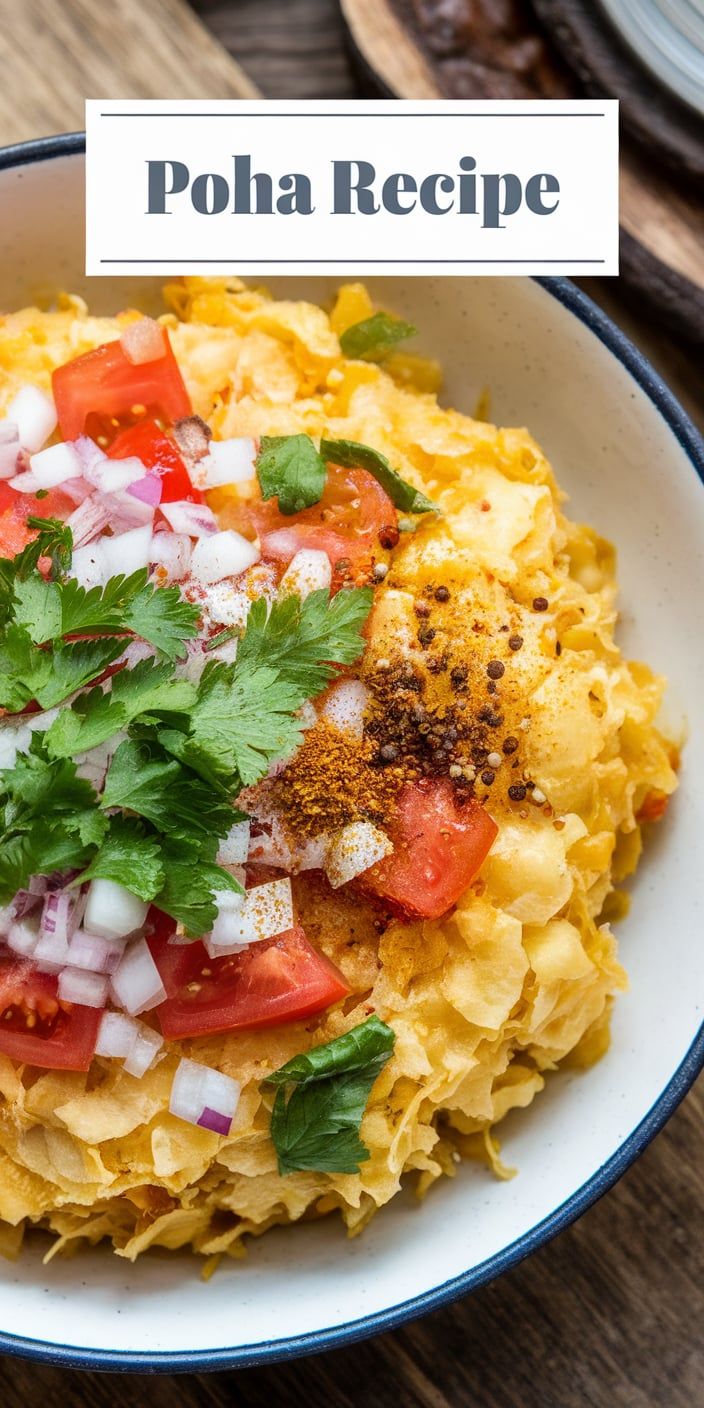Welcome to my culinary journey exploring the beloved poha recipe, a vibrant and delicious Indian breakfast that has captured my heart. As a passionate home cook, I’m excited to share this flattened rice dish that brings warmth and flavor to any morning table.
Poha, a traditional Indian breakfast, offers a perfect blend of simplicity and taste. This light yet satisfying poha recipe transforms humble flattened rice into a mouthwatering meal that can be prepared in minutes. My approach focuses on creating an authentic experience that brings the rich flavors of Indian cuisine directly to your kitchen.
Whether you’re a cooking enthusiast or someone looking to explore new breakfast options, this poha recipe will become a cherished addition to your culinary repertoire. I’ll guide you through each step, ensuring you can create a delectable Indian breakfast that’s both nutritious and incredibly delicious.
Get ready to discover the magic of poha – a dish that represents the heart of Indian home cooking and promises to delight your taste buds with every bite.

What is Poha and Its Cultural Significance
Poha represents a cherished culinary treasure in Indian food culture, transforming simple flattened rice into a delightful and nutritious meal. This versatile dish has deep roots in traditional Indian cuisine, capturing the essence of regional cooking styles and flavors across the country.
The poha origin stretches back centuries, with each region developing its unique interpretation of this beloved breakfast staple. From the bustling streets of Mumbai to the quiet kitchens of rural India, poha has become more than just a meal – it’s a cultural connection that brings families and communities together.
Origins of Poha in Indian Cuisine
Tracing the roots of poha reveals a fascinating culinary journey. Flattened rice has been a staple in Indian diets for generations, with evidence of its consumption dating back to ancient times. Different regions developed distinctive preparation methods that reflect local tastes and available ingredients.
- Maharashtra: Known for Kande Pohe, a spicy version with onions
- Madhya Pradesh: Famous for Indori Poha with a unique tangy twist
- Bengal: Prepares a lighter, more subtle version of the dish
Regional Variations Across India
Each region brings its own personality to poha preparation. The diversity of recipes showcases the incredible culinary creativity found across Indian cuisine. From coconut-infused versions in the south to spicier preparations in the north, poha adapts to local palates with remarkable versatility.
Nutritional Benefits of Flattened Rice
Flattened rice nutrition makes poha an excellent choice for health-conscious food lovers. Packed with essential nutrients, this lightweight grain offers multiple health benefits. It’s low in calories, easily digestible, and provides a good source of carbohydrates for sustained energy throughout the morning.
- Low glycemic index
- Rich in iron and vitamin B
- Gluten-free and easy to digest
Whether you’re a culinary enthusiast or someone seeking a nutritious breakfast, poha offers something special for everyone. Its rich history and incredible versatility continue to make it a beloved dish in Indian households and beyond.
Essential Ingredients for Perfect Poha Recipe
Creating an authentic poha dish requires understanding its key poha ingredients. The star of this beloved Indian breakfast is flattened rice, which forms the base of the entire recipe. I’ll walk you through the essential components that transform simple flattened rice into a delectable meal.
Let me break down the must-have ingredients for a traditional poha recipe:
- Poha (flattened rice) – 2 cups
- Onions – 1 medium, finely chopped
- Green chilies – 2-3, sliced
- Fresh curry leaves
- Peanuts – 1/4 cup
For the perfect blend of Indian spices, you’ll want to include:
- Mustard seeds
- Turmeric powder
- Salt to taste
- Lemon juice
- Fresh coriander leaves
The magic of poha lies in its simplicity and the careful balance of these ingredients. Each spice and component plays a crucial role in creating the dish’s signature flavor profile. I recommend using fresh ingredients to enhance the taste and authenticity of your poha.
Optional add-ins can include boiled potatoes, grated coconut, or scrambled eggs for extra nutrition and flavor. The beauty of poha is its versatility – you can easily customize it to suit your taste preferences or dietary needs.
Kitchen Tools and Equipment Needed
Preparing delicious poha requires the right poha cooking tools and Indian kitchen equipment. I’ve discovered that having the proper tools can transform your cooking experience from challenging to delightful. The key is selecting equipment that makes your cooking process efficient and enjoyable.
Let me walk you through the essential tools that will elevate your poha-making skills:
- Heavy-bottom kadai or non-stick pan for even heat distribution
- Sharp chopping knife for precise vegetable cutting
- Measuring cups and spoons for accurate ingredient proportions
- Colander for rinsing and draining flattened rice
Traditional vs Modern Cooking Methods
Traditional poha preparation relies on manual techniques, while modern time-saving gadgets have revolutionized kitchen efficiency. I recommend a balanced approach that combines classic cooking wisdom with contemporary kitchen technology.
Time-Saving Kitchen Gadgets
For busy home cooks, several Indian kitchen equipment innovations can streamline poha preparation:
- Electric rice cookers with quick-cook settings
- Food processors for rapid vegetable chopping
- Digital kitchen scales for precise measurements
- Instant-read thermometers for perfect cooking temperatures
By investing in these versatile poha cooking tools, you’ll dramatically reduce preparation time while maintaining authentic flavor and texture.
Step-by-Step Poha Recipe
Mastering the art of poha cooking instructions requires precision and passion. This Indian breakfast recipe transforms flattened rice into a delightful morning meal that’s both nutritious and delicious. Let me walk you through my personal method of flattened rice preparation that guarantees perfect results every time.
- Rinse the Poha
Gently wash 2 cups of poha (flattened rice) under cool water. Drain immediately and let it rest for 5-7 minutes to soften without becoming mushy.
- Prepare Ingredients
Chop 1 medium onion, 1 green chili, and gather 2 tablespoons of fresh cilantro. Have your spices ready: mustard seeds, curry leaves, and turmeric powder.
- Tempering Process
Heat 2 tablespoons of oil in a wide pan. Add mustard seeds and let them splutter. Toss in curry leaves and chopped onions, sautéing until golden brown.
- Combining Ingredients
Sprinkle turmeric and salt over the softened poha. Gently mix to ensure even coating. Add the tempered spices and mix thoroughly.
- Final Touches
Garnish with fresh cilantro and optional roasted peanuts. Squeeze fresh lemon juice for an extra burst of flavor.
| Ingredient | Quantity | Preparation Note |
|---|---|---|
| Poha (Flattened Rice) | 2 cups | Rinse and drain quickly |
| Onion | 1 medium | Finely chopped |
| Green Chili | 1-2 | Sliced thinly |
| Oil | 2 tablespoons | For tempering |
Pro tip: The key to perfect poha is not oversoaking the flattened rice. Gentle handling ensures a light, fluffy texture that makes this Indian breakfast recipe truly special.
With these detailed poha cooking instructions, you’ll create a restaurant-worthy breakfast that celebrates the rich culinary traditions of Indian cuisine. Enjoy your homemade poha!
Tips for Making Fluffy and Non-Sticky Poha
Mastering the art of preparing perfect poha requires skill and understanding. My years of cooking experience have taught me that achieving fluffy, non-sticky flattened rice is both a science and an art. I’ll share my top fluffy poha tips to help you create restaurant-quality dishes every time.
Preventing Common Poha Preparation Mistakes
When making poha, several critical errors can compromise your dish’s texture. Here are key mistakes to avoid in your poha texture guide:
- Over-soaking flattened rice, which leads to mushy results
- Using water incorrectly during preparation
- Cooking at incorrect temperature
- Handling poha without proper resting time
Essential Techniques for Perfect Texture
Achieving non-sticky flattened rice requires precise techniques. I recommend following these professional-level strategies:
- Rinse poha quickly under cold water
- Drain immediately and let rest for 5-10 minutes
- Gently fluff with a fork to separate grains
- Use minimal moisture during cooking
Storage and Reheating Recommendations
| Storage Method | Duration | Reheating Technique |
|---|---|---|
| Refrigerated (Airtight Container) | 1-2 days | Microwave with damp paper towel |
| Room Temperature | 4-6 hours | Gentle pan heating with splash of water |
By implementing these fluffy poha tips, you’ll transform your home cooking and create consistently delicious, texture-perfect dishes that will impress your family and friends.
Delicious Variations and Add-ins
Exploring poha variations can transform your Indian breakfast ideas into exciting culinary adventures. As a passionate home cook, I’ve discovered numerous ways to elevate the classic flattened rice recipes with creative add-ins and regional twists.
My favorite poha variations bring exciting flavors and textures to this traditional breakfast dish. Let me share some incredible ways to customize your poha:
- Vegetable-Packed Versions
- Potato Poha (Batata Poha)
- Mixed Vegetable Poha
- Peas and Carrot Poha
- Protein-Enriched Options
- Egg Poha
- Sprouts Poha
- Paneer Poha
Regional Indian breakfast ideas offer unique flavor profiles that can inspire your cooking. The South Indian coconut poha brings a delightful tropical twist, while Maharashtrian-style poha adds a spicy kick with additional green chilies and fresh coriander.
| Region | Unique Poha Variation | Special Ingredient |
|---|---|---|
| Gujarat | Batata Poha | Diced Potatoes |
| Maharashtra | Spicy Poha | Green Chilies |
| South India | Coconut Poha | Fresh Coconut |
For those seeking healthier flattened rice recipes, I recommend adding nuts like cashews or peanuts for extra crunch and nutritional value. Experiment with different spices and herbs to create your signature poha dish that suits your taste preferences.
Serving Suggestions and Accompaniments
When it comes to poha serving ideas, presentation is key to elevating this classic Indian breakfast. I love transforming my poha into a vibrant and delicious meal by adding some carefully chosen garnishes. Fresh coriander leaves, a sprinkle of sev (crunchy chickpea noodles), and a generous squeeze of lemon can instantly brighten up the dish and add layers of texture and flavor.
Indian breakfast pairings can take your poha to the next level. I recommend serving it alongside a refreshing glass of nimbu pani (Indian lemonade) or a steaming cup of masala chai. For those looking to create a more substantial meal, consider adding some crispy papads, tangy pickle, or a dollop of cool yogurt to complement the warm flattened rice dish.
My favorite flattened rice garnishes include toasted peanuts for crunch, sliced green chilies for heat, and a sprinkle of fresh coconut for a tropical twist. These additions not only enhance the visual appeal but also create a more complex flavor profile that will impress your breakfast guests. Remember, the key is to experiment and find the combinations that bring you the most joy!
Pro tip: Always serve poha immediately after cooking to enjoy its perfect texture and warmth. A beautifully presented plate with thoughtful accompaniments can transform this simple dish into a memorable culinary experience that celebrates the rich traditions of Indian cuisine.
